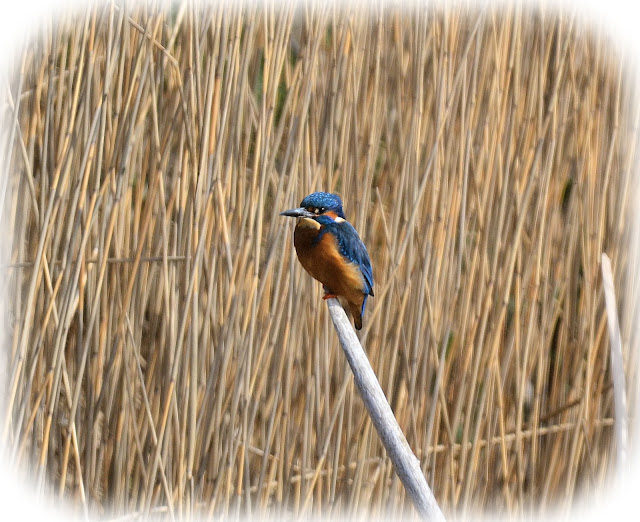An early morning arrival found myself at Rainham RSPB before the drawbridge had been lowered, never noticed that before, so I thought I would have a walk down the River Thames foreshore path to see if I could find any newly arrived Wheatears, but no such luck.
A brisk walk back to the main entrance where the drawbridge had now been lowered, and I was heading towards the Marshland discovery zone in the hope of a Kingfisher sighting.
The camouflage netting was up across the viewing windows, always a good sign, as I walked in through the door, I could see a Kingfisher perched on a carefully placed tree branch on the water's edge near the breeding tunnel, put there for just such a purpose.
A few moments later it flew towards the tunnel and was lost to view, re-emerging shortly afterwards for a quick dip in the water, before it was off across the marshes.
I managed to maneuver myself to a prime spot where I could just get the camera lens through the netting with a good view of the 'stick'.
Experience has taught me that this particular Kingfisher usually returns at twenty minute intervals, I decided to wait and try and get some decent photograph s of this lovely looking bird.
Twenty minutes seems like an eternity when you are focused on as stick in the water, and not much else happening.
The Kingfisher returned as expected, just a few minutes later than I thought, this time it perched on the stick, for a good five minutes or so, occasionally looking around, but quite content and at peace.
Which is more than I can say for the MDZ hide, the continuous shutter noises from the cameras waiting for just such a view, sounded deafening, but the kingfisher thankfully was unperturbed.
The photographs I managed are all very 'samey', but any Kingfisher photograph is usually sought after, the Kingfisher just sat there hardly moving, which certainly makes a change. It did fly to another stick close to the breeding tunnel where it again just sat waiting for something, maybe a female.
The Kingfisher in question appears to be a male bird, the all black bill indicates this, the female usually has some red in the lower mandible.
The rest of the walk was a bit of a anti-climax, no migrant sightings for me, a few Butterflies, a Brimstone always on the move, do they ever settle, Peacock and a Small Tortoiseshell.
 |
| Small Tortoiseshell |
I did witness some strange behaviour from some Canada Geese, the individual in the photograph appeared to have wandered to close to an established pair, it then proceeded to slink away, as low down in the water as it could, just its head and body showing above the water, it was still spotted, the established pair flew over to it pouncing on the poor bird, unusual to see a Canada goose so passive.
 |
| retreating Canada Goose. |
Although no migrant sightings, a lovely day on the marshes.


















































